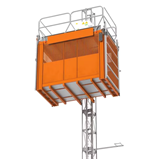The slightly steeper rate of decline in February reflected a further weakening in new orders, which declined by 6.9 points to 38.7. The recent softening in overall industry conditions continued, although the activity (44.7 points), deliveries from suppliers (46.7 points) and employment (47.6 points) sub-indexes were all relatively unchanged from January.
Weighing heavily on industry conditions in February were sharper falls in mining-related engineering construction (down 2.0 points to 42.7) and commercial building (down 7.2 points to 41.8), which bore the brunt of the decline in new orders.
House building declined for a third consecutive month, if at a slower rate (up 4.5 points to 45.4), while apartment building solidly returned to growth (up 10.8 points to 53.1) – a reflection of recent ABS data indicating increases in dwelling approvals for apartments and other multi-unit dwellings.
Ai Group Director – Public Policy, Peter Burn, said: "Notwithstanding the return to growth in apartment building, further declines in house building and in commercial and engineering construction in February saw the overall contraction in the construction sector extend into a fourth month.
"While house building is retreating from relatively healthy levels, it is no longer offsetting the well-entrenched decline in mining-related engineering construction activity. The near-term outlook for the sector is for continuing declines in activity, as suggested by the low level of new orders revealed by survey respondents."
HIA Chief Economist, Harley Dale, said: "The dichotomy to Australia's construction industry continues in 2015, with non-residential construction in varying stages of weakness, but the residential sector looking relatively strong.
"Detached housing 'reads' for the PCI are weaker overall, but still consistent with historically elevated volumes of construction, while the apartment sector has bounced back as we expected. The release of the Intergenerational Report yesterday highlighted the challenges our economy faces beyond short-term updates such as that exemplified by today's weak headline PCI.
"A front and centre focus on housing policy reform would lift economic growth but also deliver important productivity gains, the latter of which should form a cornerstone of any accurate discussion of yesterday's IGR."
Australian PCI – Key Findings for February:
- The Ai Group/HIA Australian Performance of Construction Index (Australian PCI) contracted for a fourth consecutive month in February, decreasing by 2.0 points to 43.9.
- Indexes for construction activity (44.7 points), deliveries from suppliers (46.7 points), and employment (47.6 points) all remained largely unchanged from January, but new orders dropped a further 6.9 points to 38.7.
- The rate of capacity utilisation across the construction industry increased by 6.1 percentage points to 72.6 per cent – only slightly above the 12-month average of 72.2 per cent of total industry capacity being utilised.
- Three of the four construction sub-sectors contracted in February: house building declined for a third month, although the rate of contraction moderated (up 4.5 points to 45.4); engineering construction continued to decline (down 2.0 points to 42.7); and commercial construction weakened amid subdued building approvals (down 7.2 points to 41.8). Apartment building, however, returned to growth, with its sub-index rising a solid 10.8 points to 53.1.
- Pressures on profit margins remain intense: growth in the wages sub-index continued, and at a stronger pace (up 5.4 points to 60.0), while input costs picked up with the lower dollar (up 6.6 points to 79.2). This placed pressure on businesses to raise selling prices, but the overall expansion in prices was marginal (up 5.9 points to 51.9 – slightly above the 50-points no-change threshold).












